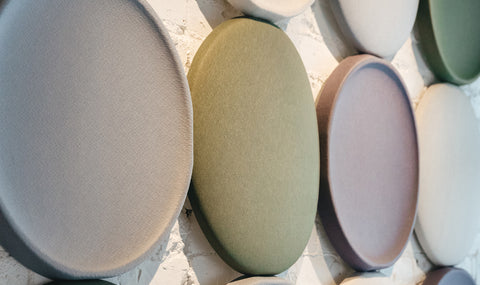Office Acoustics - An Essential Design Element for your Office Space

With the advent of open plan offices and open plan living, internal walls are disappearing off design plans. Hard surfaces such as concrete, wood and steel are in popular in modern interiors. This means that office acoustics are essential when considering your office design and layout.

How Sound Travels
If we want to improve the acoustics in an office, we need to understand how sound waves travel. Sound waves are energy transfers from cell to cell within almost any medium. Sound is vibration, therefore when a sound strikes a hard surface it’s reflected back. Whereas when sound energy passes over a fibrous acoustic material the energy is absorbed and converted to kinetic energy. The more fibrous a material, the better the absorption of sound. In addition, the hard, dense surfaces in the modern office often reflect sound and make it appear louder.

Business leaders realise the huge benefits that team collaboration has on productivity. However, a side effect of collaboration is the increased noise created. Colleagues who are trying to focus on work can be disrupted by nearby collaborative discussions. The two needs can be conflicting if taking place in an open place office space.
Good or bad acoustics have a significant impact on productivity, employee satisfaction, and health in your workspace.
The ways in which we work are more varied than ever before, but are you providing the right sound environment to ensure health, success and productivity?
Unwanted sound, or noise, is a major consideration in workplaces where employees function in close proximity, often with different expectations and needs regarding sound control in the work space.
The effects of poor acoustics in a work place can mean decreased productivity, errors, inefficient use of resources, and ultimately, worsened financial performance. From the perspective of the staff, uncontrolled noise can increase stress levels.

Noise is probably the most prevalent annoyance source in offices, and can lead to increased stress for workers
Why workplaces are becoming nosier?
A combination of factors has resulted in workplaces becoming noisier in the past decade including:
- Workplaces ‘opening up’ and encouraging greater mobility and communication between employees
- The focus on teams and groups collaborating in the workplace
- Workstation densities increasing and workstation areas decreasing
- Wireless technologies making it possible for employees to work in any location within the workplace
- Heating, ventilation and air conditioning equipment (HVAC) becoming so quiet that it no longer provides enough white noise to adequately mask office conversation.
The importance of reducing noise in the workplace
It is so important that work space design actively reduces the impact of noise for staff. In Australia, an important contribution to receiving the highest Green Star accreditation (six stars) is to manage the sound (or noise) within a workspace – both internal and external sounds. From an employee perspective, if we can reduce noise we can increase acoustic comfort and promote positive employee and work effectiveness outcomes (such as reducing stress and increasing concentration).
Research demonstrates that workplaces should aim to provide ‘non-intrusive privacy’ to minimise conversational distractions and increase conversation privacy.
The design of office interiors has changed considerably. In the millennial age, private offices virtually disappeared and in their place open and collaborative spaces have been added. This new style of work environment is almost expected by graduating high school and university students because they were born during this shift and are conditioned to work in these spaces, but what about those who were not conditioned?

Most modern offices have spaces dedicated for collaborative work, with small huddle spaces dedicated for conferencing and more private work. These collaborative work areas, designed for group interaction and discussion, can often be a source of high levels of noise which can then travel to other parts of the work space and interrupt those doing more private work. Another issue to look at is if you have multi-generational office spaces, those accustom to higher partitions and quieter work spaces may not work as well in a more open spaces.
At workspacedirect we offer many acoustic solutions for various spaces in your business. There are endless possibilities for applying these acoustic products in your offices spaces.
Visually Acoustics product are now art pieces for your office that add more than acoustic benefits.



We encourage “energetic and lively” work places, in fact we love them! But sound control is major consideration when designing or modifying your offices.
View some of our Acoustics Range Here or Contact our team today to discuss Office Acoustic options specifically for your work space and issues.
- Tanya Hanrahan







